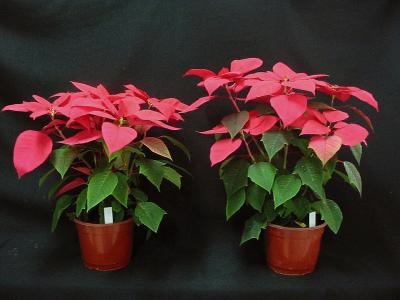
Features
Inputs
PGRs
Plentiful poinsettias possible without PGRs
November 6, 2009 By American Society for Horticultural Science
 Nov. 6, 2009, Buenos Aires, Argentina – Prior research has reported the successful use of a technique
Nov. 6, 2009, Buenos Aires, Argentina – Prior research has reported the successful use of a technique
termed “light manipulation” to affect plant height in some ornamental plants. Researchers in Argentina have been studying its potential with poinsettias.
Nov. 6, 2009, Buenos Aires, Argentina – Poinsettias can be a
lucrative crop for ornamental plant growers, particularly during the Christmas
season. In the temperate regions of the southern hemisphere, where poinsettias
are grown for both export and local markets, high-demand time for holiday sales
occurs during the summer, when warm temperatures and stronger light can
accelerate plant growth, often resulting in unmarketable plants.
To produce more sought-after consumer favourites, commercial
growers are challenged to control poinsettias’ growth rates in unfavourable
environmental conditions. Many growers use chemical plant growth regulators
(PGRs) to achieve desired plant height, but the high cost of PGRs,
environmental use restrictions, and increasing pressure from consumers to find
alternatives to chemical applications are driving researchers to explore new,
sustainable alternatives.

|
| This photo shows poinsettia plants cultivated under a photoselective (left) and a transparent (right) film. Photo by Diego Mata |
Prior research has reported the successful use of a technique
termed “light manipulation” to affect plant height in some ornamental plants.
The technique involves using specific photoselective films to reduce the far-red
component of light in the environment surrounding the plants. Consequently, the
proportion of the active form of the phytochromes – a family of photoreceptors
that absorb red and far-red light in plants – increases, playing an important
role in defining the makeup of plants and, ultimately, their market value.
Argentine researchers recently completed a study to determine
if manipulation of light quality can be a successful alternative to the use of
chemical plant growth regulators for producing high-quality poinsettia plants.
Diego A. Mata of the Instituto de Floricultura (INTA) and Javier F. Botto of
the Universidad de Buenos Aires published the results of their experiment in a
recent issue of HortScience.
The team evaluated different architectural and quality
components of ‘Freedom Red’ poinsettia plants cultivated with natural radiation
under different red (R) and far-red (FR) ratios in combination with or without
the application of plant growth regulators. Photoselective film was used to
significantly reduce the FR component of the light, and a transparent film was
used as control to obtain high and low R/FR ratios (5.7 and 1.1, respectively).
Results of the experiments indicated that poinsettia plants
cultivated under a high R/FR ratio were shorter and more compact than those
grown under transparent film. Flowering time was slightly delayed in plants
grown under a high R/FR ratio compared with those cultivated under the control
treatment. Additive effects were detected between light quality and PGR factors,
indicating that light quality manipulation is an alternative strategy to reduce
or to replace the use of PGRs in commercial production systems that usually
require several PGR applications.
“In summary”, said Mata and Botto, “our results show that light
manipulation is an effective alternative to the application of PGR to control
plant architecture in ‘Freedom Red’ poinsettias without affecting plant quality
components under high natural irradiance conditions of temperate regions. The
use of photoselective filters that increase the R/FR ratio in the cultivation
environment reduces plant height and conserves the plant quality parameters.”
Although the experiment suggests that light manipulation can
be beneficial for producing ornamental poinsettia plants using an
environmentally friendly strategy, the scientists caution that the techniques
used in this study should be evaluated under realistic production systems
before it can be recommended to growers.
The complete study and abstract are available on the ASHS
HortScience electronic journal website:
http://hortsci.ashspublications.org/cgi/content/abstract/44/3/702.
Founded in 1903, the American Society for Horticultural
Science (ASHS) is the largest organization dedicated to advancing all facets of
horticultural research, education, and application. For more information, visit ashs.org.
Print this page